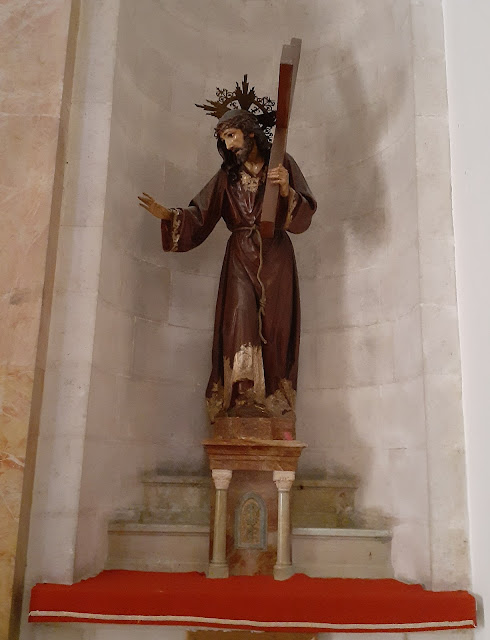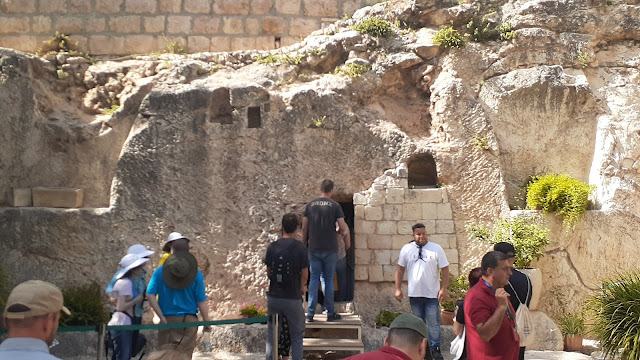In this final post of our trip, I wanted to focus on Jerusalem and Jesus' journey as our savior. In this picture you can see the wall around the old city. In the center is Dome of the Rock, one of the holiest sites in Judaism, Islam and Christianity. It sits at the top of Mount Moriah where Abraham went up to sacrifice his son.
As Jesus entered Jerusalem for the last time on what we celebrate as Palm Sunday, he first saw the city from this place where he wept. (Luke 19:41). It's called the Dominus Flevit.
Our guide showed us the Upper Room just outside the city wall where Jesus sent his disciples ahead of him to prepare the Passover dinner. (Mark 14:15, Luke 22:12)
Although the original Upper Room was destroyed in a seige, it was rebuilt in 1187.
The Garden of Gethsemane, which means "garden of the olive press," looked different that I expected. Several of the olive trees in this garden are 2,000 years old and still producing olives today.
The church here in the garden, called the "Church of All Nations," has a frame of thorns surrounding the rock where Jesus prayed the night he was betrayed.
We then walked the Via Dolorosa, or Way of the Cross.
Stations 1 & 2 - Jesus is condemed and receives his cross. Here we saw the areas where he was flogged, tried, and sentenced to be crucified. There are Catholic churches everywhere commemorating these special sites, and while they have beautifully preserved the exact location through the centuries, they obstruct the view of what it must have looked like back in Jesus' time. You had to use your imagination for a lot of it. This particular statue in one of the churches moved me because of the blood-stained robe depicted.
Here's what the streets look like. They are very narrow. This was on the Sabbath when the vendors were closed, but it's usually crowded with lots of people buying fruit, clothing, toys, shoes, and other essentials like a flea market. I stayed close to the tour group on our way back because it was easy to lose them.
As Jesus walked down these streets, the crowds must have gawked and stood along the walls as the guards made way for Jesus and his cross.
Some of the stations, like #7 whre Jesus falls for the second time, have small prayer chapels.
As we neared the Church of the Holy Sepulcher, the stations were all contained within the complex gates. Our guide led us up to calvary through a series of buildings, arches, and steep stairwells.
At the top of the stairs, there was a huge crowd of tourists like us gathered along the side. Here we saw paintings and mosaics over the places where Jesus was stripped and nailed to the cross. The altar marks the spot where Jesus died on the cross. We couldn't see it just yet beause Greek Orthodox priests were saying Mass.
When it was okay to proceed, each person took a brief moment to go under the altar and place our hand on the rock that supported Jesus's cross as he died.
The tomb, or Holy Sepulchre, is inside the building complex with a memorial building made of marble covering it. They also had a guard waiting at the entrance who would only allow 4-5 people in at a time for a total of 5 seconds, and no pictures. The lines were long, so I actually appreciated this.
You might notice the candles. Vendors were selling these everywhere in the streets. Many cultures light candles in these holy places for a few minutes, then blow them out and bring back the burned candles to family and friends back home to keep in special places.
Something interesting about the Holy Sepulchre complex is that several Christian denominations have a physical presence there, including the Armenians, Greek Orthodox, Ethiopian, Catholic, Syriac, and Coptic Christians. To keep these groups from quarreling about who gets to keep the keys to the complex, it was agreed in 1291 to give the keys to the Muslims.This has worked well ever since. At 4:30am, they open the doors and at 8pm the doors are closed, every day. It's a great example that through God, there really can be peace.
In 1867, a rock-cut tomb in Jerusalem was unearthed and is considered by some Protestants to be the site of the burial and resurrection of Jesus. It's clled the Garden Tomb, and has been dated by Israeli archaeologists to around 700 BC. Although it's within walking distance of the crucifixion, it doesn't match the description in the bible as a "new" tomb. (John 19:41) Regardless of which tomb is perceived as true, the important thing is that they are both empty which gives us our shared faith.
As we concluded our tour of Egypt, Jordan, and Israel, we all got certificates of our Pilgrimage. Here is a picture of all 14 of us with Jerusalem in the background. It was a fantastic trip with a wonderful tour company. I wouldn't recommend this travel without them! www.Vacations4Less.com (or www.IsraelTourismConsultants.com).


















